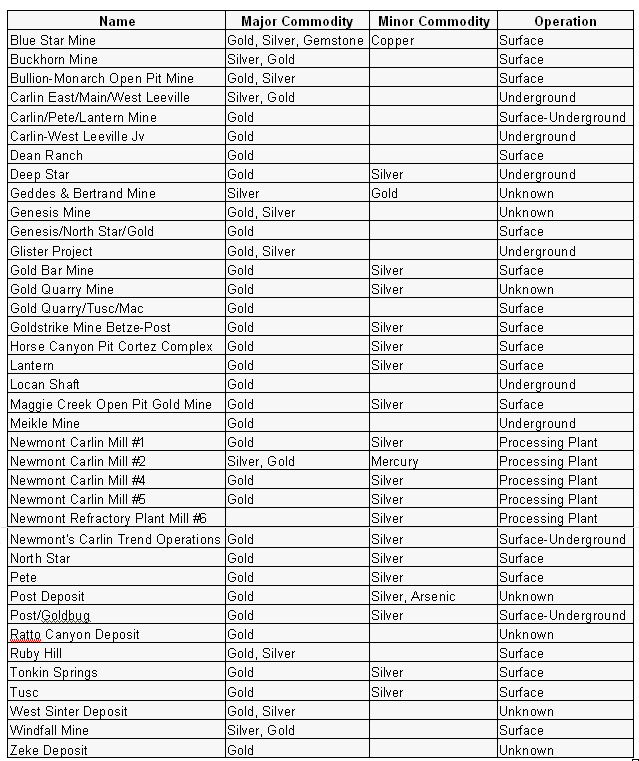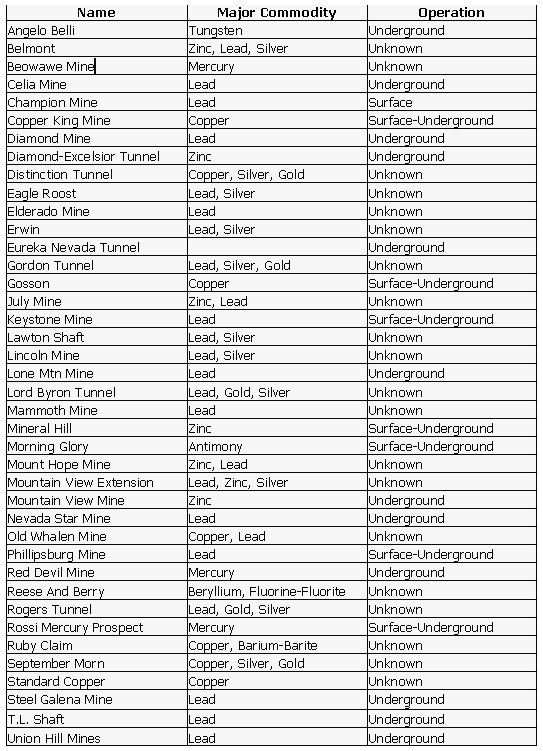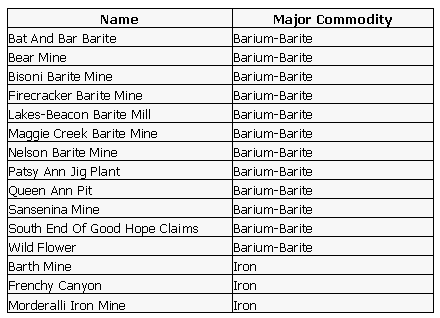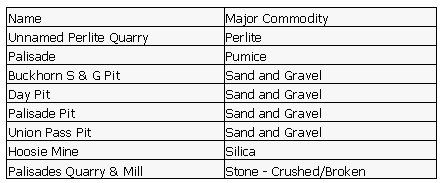3. MINERAL RESOURCE OCCURRENCES - Continued
 3.1.5 Precious Metals 3.1.5 Precious Metals
The occurrences of precious metal deposits are discussed in this section. Figure 3.1.5a [link below] indicates the locations of precious metals throughout Eureka County. Figure 3.1.5b, 3.1.5c, 3.1.5c, and 3.1.5d present a closer view of the important mineral resource areas of Eureka County.
The proposed rail corridor is in the general vicinity of two precious metal mineral resources. Table 3.1.5 presents the plants and producing Precious Metal Mines in Eureka County.
Table 3.1.5: Plants and Producing Precious Metal Mines in Eureka County

 Gold Gold
Nevada' gold production in 2004 was 6,942,000 troy ounces (Driesner and Coyer, 2005) and was valued at approximately $2.7 billion. Nevada is the third largest gold producer in the world, behind only the countries of South Africa and Australia. Estimated proven and probable gold reserves at currently active mines at the end of 2005 is estimated at 33 million troy ounces (Price and Meeuwig, 2006). Most of the precious metals and many of the other metals are currently being produced from recently developed (since 1982) open-pit mines of varying sizes (some open pits are as much as a kilometer in size). Note that some of the Carlin mines include underground mines.
The gold ore in Eureka is typically processed by a combination of oxide mills, refractory mills, and heap leach methods. Oxide mills leach the ores in agitating tanks in alkaline cyanide solution followed by absorption in a carbon pulp. Refractory mills fine grind the ore and oxidize it by roasting, thus freeing the gold particles for additional processing. Heap leaching is used for the high tonnage / low grade ore and it is crushed and placed on a large leach pad where it is irrigated with a cyanide solution. Refractory and oxide milling has become an important part of the ore processing as the large operations are relying on this newer technology.
Gold producers report increased costs of production, due mostly to energy costs. To address these rising costs, Newmont's Nevada operations are building a 203-megawatt coal-fired power plant near the Carlin operations at Dunphy. The company plans to sell excess capacity from the plant to local utility Sierra Pacific.
 Betze/Post Mine — The Betze/Post Mine is an open pit gold mine, operated by Barrick Gold Corporation. The host rock consists of chert, shale, siltstone, and impure carbonates. Betze/Post mine is located in the Lynn mining district. In 2005, the Betze/Post mine produced 1,514,320 ounces of gold and 114,248 ounces of silver. Betze/Post Mine — The Betze/Post Mine is an open pit gold mine, operated by Barrick Gold Corporation. The host rock consists of chert, shale, siltstone, and impure carbonates. Betze/Post mine is located in the Lynn mining district. In 2005, the Betze/Post mine produced 1,514,320 ounces of gold and 114,248 ounces of silver.
 Carlin Mines — The Carlin mines are open pit and underground gold mines, operated by Newmont Mining Corporation. The host rock consists of limestone, argillite chert, and sedimentary rock. Carlin mines are located in the Lynn and Maggie Creek mining districts. In 2005, the Carlin mines produced 684,400 ounces of gold. Carlin Mines — The Carlin mines are open pit and underground gold mines, operated by Newmont Mining Corporation. The host rock consists of limestone, argillite chert, and sedimentary rock. Carlin mines are located in the Lynn and Maggie Creek mining districts. In 2005, the Carlin mines produced 684,400 ounces of gold.
 Ruby Hill Mine — The Ruby Hill Mine is an open pit gold mine, operated by Barrick Gold Corporation. The host rock consists of limestone. Ruby Hill mine is located in the Eureka mining district. In 2004, the Ruby Hill mine produced 8,057 ounces of gold and 1,888 ounces of silver. Ruby Hill Mine — The Ruby Hill Mine is an open pit gold mine, operated by Barrick Gold Corporation. The host rock consists of limestone. Ruby Hill mine is located in the Eureka mining district. In 2004, the Ruby Hill mine produced 8,057 ounces of gold and 1,888 ounces of silver.
 Silver Silver
Nevada' silver production in 2004 was 9,946,000 troy ounces making it Nevada's 5th leading mineral commodity, valued at $71 million (Price and Meeuwig, 2006). In Eureka County silver is a secondary precious metal in the existing gold mines, as previously indicated.
 3.1.6 Other and Base Metals 3.1.6 Other and Base Metals
Eureka County contains numerous other metal and base metallic deposits and a number of these have been exploited historically for their intrinsic non-precious metals value. Often these metals have been produced as a by-product of gold and silver mining. Figure 3.1.5 indicates the locations of base metal (copper, etc.) mineral resources. Table 3.1.6a presents the plants and producing Base Metal Mines in Eureka County. Table 3.1.6b presents the past producing Base Metal Mines in Eureka County.
Table 3.1.6a: Plants and Producing Base Metal Mines (Present)

Table 3.1.6b: Plants and Producing Base Metal Mines (Past)

 Copper Copper
Nevada produced 126 million pounds of copper in 2005 (Price and Meeuwig, 2006). Copper was Nevada's 4th leading mineral commodity in 2005, valued at $213.3 million. However, in Eureka County copper is a minor or trace commodity in the active precious metal mines.
 Molybdenum Molybdenum
Idaho General Mines, Inc. has commenced (October, 2006) the permitting process to develop a molybdenum mine at Mount Hope in Eureka County. The Mount Hope Mine project is located near State Route 278 south of Garden Pass. Permitting is expected to take approximately two years following the submittal of a Plan of Operation to the U.S. Bureau of Land Management (USBLM). Mine construction is expected to take approximately two additional years with initial production targeted for 2009. The mine is projected to have a 53-year life and produce approximately 1.3 billion pounds of molybdenum.
 Uranium Uranium
Uranium resources are present in Eureka County. The occurrence of uranium mineral resources of Eureka County are presented in Figure 3.1.5. Table 3.1.6c presents the uranium resources in Eureka County.
Table 3.1.6c: Uranium Resources

 3.1.7 Gems and Semi-Precious Stones 3.1.7 Gems and Semi-Precious Stones
Various gemstones are found in Eureka County. Turquoise mining takes place in Eureka County, but the activity is intermittent and largely unreported. Figure 3.1.5 indicate gemstone occurrences within Eureka County. Table 3.1.7 presents the past producing gemstone mines in Eureka County.
Table 3.1.7: Past Gemstone Mines

 3.1.8 Industrial Minerals 3.1.8 Industrial Minerals
Industrial mineral resources are present in Eureka County. The occurrence of locatable industrial rock and mineral resources of Eureka County are presented in Figure 3.1.5. At this time there is a limited number of active mines of industrial minerals in Eureka County. Table 3.1.8a presents the producing Industrial Mineral Mines in Eureka County. Table 3.1.8b presents the past producing Industrial Mineral Mines in Eureka County.
Table 3.1.8a: Producing Industrial Mineral Mines

Table 3.1.8b: Past Industrial Mineral Mines

 3.2 Saleable Minerals 3.2 Saleable Minerals
For saleable minerals, the primary commodity sold to the public is sand and gravel. A minor quantity of decorative and building stone, clay and decomposed granite is also sold to the public. Nevada's construction aggregate production in 2005 was estimated at 46 million tons at a value of $207 million (Price and Meeuwig, 2005). It is estimated that Eureka County produced less than 100,000 tons of aggregate (Price and Meeuwig, 2005). Table 3.2a presents the producing Saleable Mineral Mines and Table 3.2b presents the past producing Saleable Mineral Mines in Eureka County
Table 3.2a: Producing Saleable Mineral Mines

Table 3.2b: Past Saleable Mineral Mines

 3.3 Leasable Minerals 3.3 Leasable Minerals
Leasable minerals defined by the Mineral Leasing Act (February 1920; and 43 CFR 3000-3599, 1990) include the subsets leasable solid and leasable fluid minerals. Leasable solid minerals include: coal, oil shale, native asphalt, phosphate, sodium, potash, potassium, and sulfur. Leasable fluid minerals include oil, gas and geothermal resources. The rights to explore for and produce these minerals on public land may only be acquired by competitive leasing.
|

